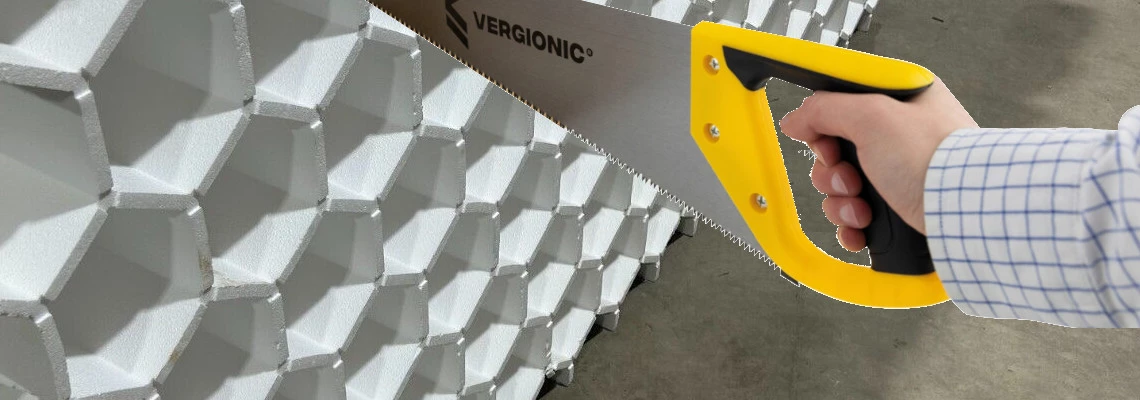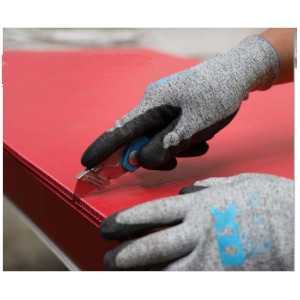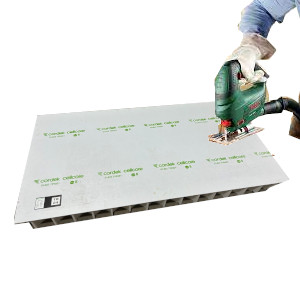
HOW TO CUT POLYSTYRENE VOID FORMER?*
Polystyrene void formers such as Cordek HX S Under Slab or Filcor 20 truly revolutionise the battle against the impact of clay on foundations. These products are lightweight, easy to install, but the only tricky part is cutting them to size.
In this article, you will find the most common techniques used for cutting polystyrene void formers and the tools you should use.
POLYSTYRENE VOID FORMER STRUCTURE
The Polystyrene void former is mostly made of expanded polystyrene (EPS), a light material with tiny holes. EPS is created by treating polystyrene beads with a special agent and then heating them with steam. This process makes the beads expand and stick together, creating a strong foam structure This expanded foam material is versatile, known for its density, thermal insulation capabilities, and ease of shaping, making it a popular choice in various applications, including void formers.
Given that polystyrene is composed of approximately 90-98% air, cutting it should not pose significant challenges, provided appropriate tools and techniques are employed.
TYPES OF POLYSTYRENE VOID FORMER
In the UK, there are two types of polystyrene void formers commonly employed in ground works: compressible under-slab void formers made of EPS legs, like Cordek HX S, and void fillers used for forming openings and voids within concrete structures such as Filcor 20 or Filcor 45.
Utilising EPS as a lightweight fill has been a common practice in the UK for more than three decades and globally for half a century.
The initial void former described is constructed with moulded legs featuring a robust 10mm top, providing the ability to walk on it. The legs, composed of EPS, include drainage holes, making it ideal for locations with a high water table or coastal areas. The slots facilitate the release of water trapped in compressed cells when the board is compressed.

Pic.1 Corde Cellocre HX S under slab
As shown in the diagram, the upper part looks like Corex, and the legs under the slab are moulded from expanded polystyrene (EPS). Therefore, cutting it should be much easier than a solid block of styrofoam like Filcor 20.
Filcor 20, a type of void filler, is a solid block made of EPS without any empty spaces. Cutting it can be a bit trickier compared to the under-slab void former we discussed earlier.

Pic.2. Filcor boards
CUTTING POLYSTYRENE UNDER SLAB VOID FORMER
Cellcore polystyrene under slab void former is extremely easy to cut with a compact Stanley knife, due to the hollow and polystyrene free nature of the construction.To cut the polystyrene under slab void former to size, best would be to use a Stanley knife and handsaw. Begin by cutting through the top layer of twin-fluted polypropylene with the knife, and then cut the base, which consists of EPS legs, using a fine-tooth handsaw. The legs are relatively thin, forming a square or hexagonal shape, and should be cut with a fine-tooth handsaw.

Pic.3 Tools needed to cut polystyrene void former
Picture credit:premcrete.com
It is crucial to avoid any mechanical breaking or joining of these legs. Otherwise, it could lead to uneven concrete pressure and the risk of collapsing at weakened points. Typically, it is advisable to avoid connecting smaller pieces of the board and use complete integrated void formers whenever possible.
Polystyrene under-slab void formers are available in three heights: 90mm, 160mm, and 225mm. The 90mm or 160mm heights can also be cut at low speeds using a jigsaw. Jigsaw blades come in various lengths, and using a blade designed for cutting metal ensures a high-quality cut, expediting the board installation process.

Using a hot wire cutter is not recommended for cutting polystyrene under-slab void formers because they are coated with twin-fluted polypropylene, which can generate toxic fumes.
CUTTING POLYSTYRENE VOID FILLER
Cutting a polystyrene void filler like Filcor 20 is incredibly simple and can be done manually using a handsaw or mechanically with a hot wire cutter. Using a handsaw is recommended for thicknesses up to 150mm. Cutting with a handsaw beyond this thickness will not only be physically challenging but is also likely to result in an uneven cut edge.
If you plan to cut a polystyrene void former with a thickness greater than 150mm, it's best to use a portable hot wire cutter. This tool ensures a perfect cut edge, and the board will always be cut at a precise angle.
A hot wire cutter utilises electrical energy to heat a wire, the cutting tool, to a temperature around the melting point of polystyrene, typically 80-90°C. This process allows the void former to be cleanly separated into two parts, creating a very aesthetically pleasing cut edge.

Theoretically, the use of a hot wire cutter has no limitations on the thickness of polystyrene void former it can cut, as long as the wire is appropriately tensioned, and its arms are of sufficient height.
If you anticipate using this type of device in the future, it might be worth considering purchasing one. However, if you plan to use it only on a single occasion, renting it seems to be the more practical option.
CONCLUSION
To cut a polystyrene void former, it's crucial to know the specific type of void former we deal with. For under slab void formers such as Cellcore HX S, using a Stanley blade and handsaw is the most effective method. On the other hand, when cutting a polystyrene block filler like Filcor 20, a hot wire cutter is the most suitable tool. For certain thicknesses of polystyrene void formers, tools such as a jigsaw can also be used, although they are less common due to the predominant thickness of thicker void formers, typically exceeding 150mm.
Related articles:
COST-EFFICIENT UK ANTI-HEAVE PROTECTION: TOP 3 NEAR YOU
Foundation heave problems. Heave Symptoms
Don't let your foundation fail
Understanding Dufaylite Honeycomb Claybord Void Former
Filcor lightweight structural fill
How to insulate under concrete floor. The ultimate guide
*Insulationgo LTD strives to keep the content accurate and up-to-date, but we cannot be held responsible for any mistakes or exclusions.
The information in this blog isn't expert advice and shouldn't replace talking to the right specialists. Before buying or deciding anything based on this info, it's best to contact the product manufacturer directly to double-check if it's right for what you need.
Descriptions, drawings, photographs, data, proportions, weights, and measured values provided here may change without prior notice and do not establish the guaranteed contractual quality of the products. The recipient of these products holds the responsibility to comply with proprietary rights, existing laws, and legislation.
Using this blog implies acknowledgment and agreement that Insulationgo LTD cannot be held accountable for any damages, losses, or inconveniences resulting from the use or reliance upon the information provided. This limitation of liability extends to all users of the blog, including visitors, readers, and subscribers.










































































































